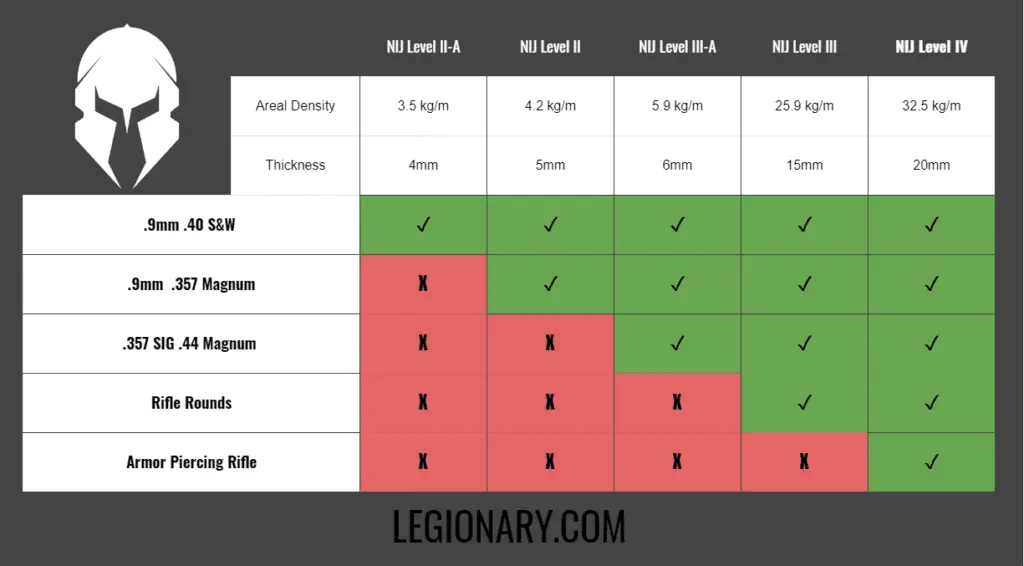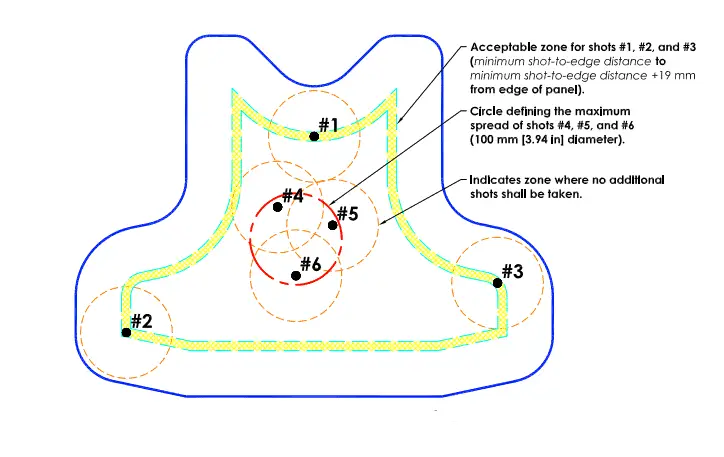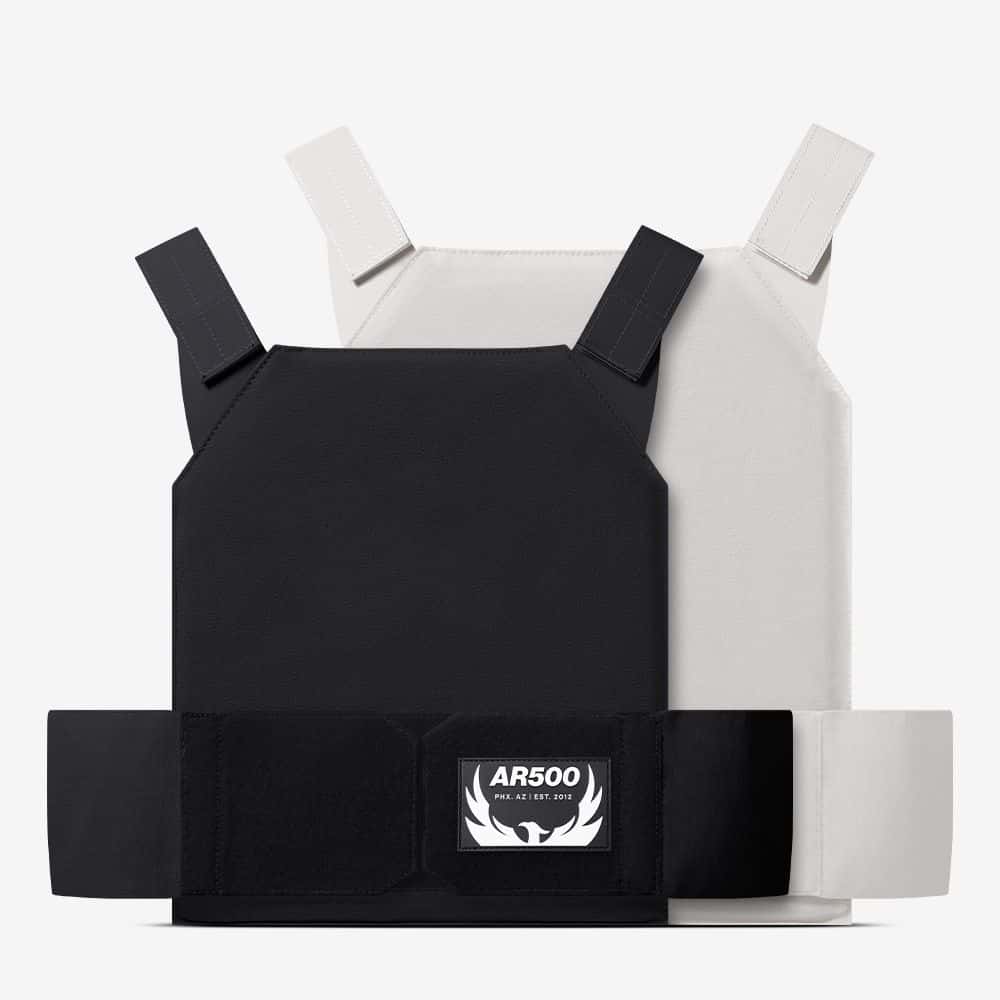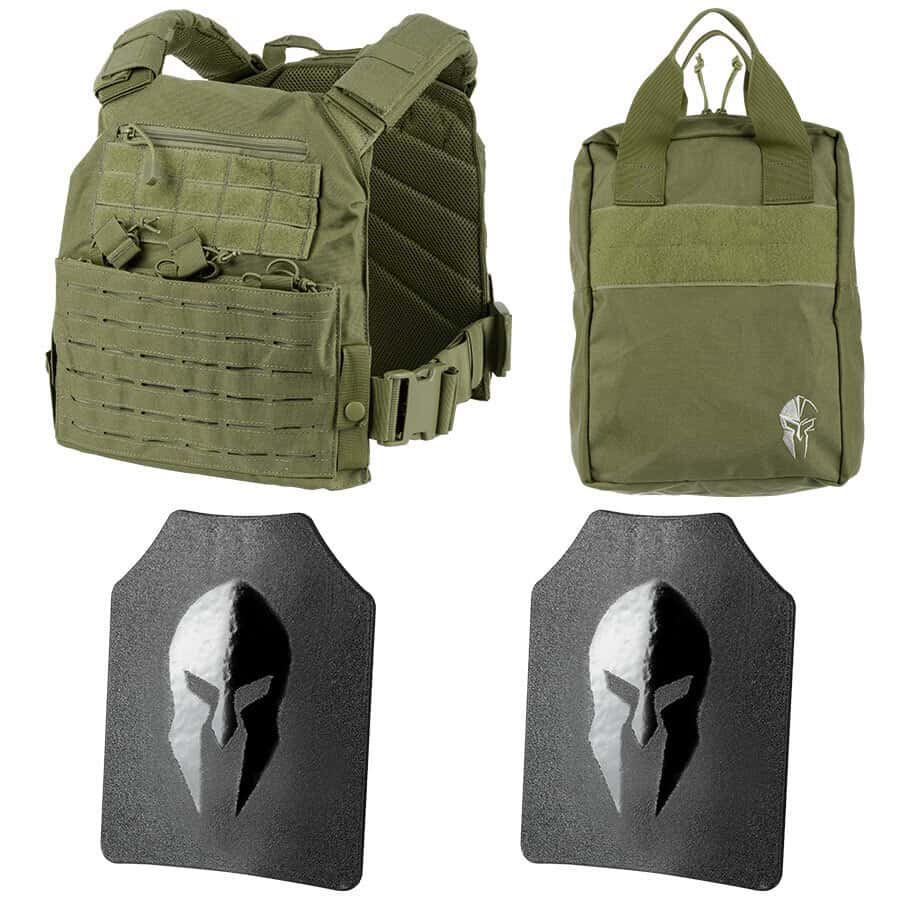There are 5 different classes of body armor levels developed by the National Institute of Justice: Level IIA, Level II, Level IIIA, Level III, and Level IV. Each level represents the armors ability to stop projectiles based on their size and velocity. Level IIA has the lowest level of protection while level IV has the highest level of protection.
Body armor is responsible for saving countless lives around the world. But those who are interested in wearable protection are often confused as to what the different body armor levels actually mean. We’re here to clear up any confusion so you know exactly what kind of body armor you need to protect yourself. What are body armor levels? Body armor levels are varying degrees of wearable protection against a wide range of ballistics attacks. There are 5 threat levels for body armor as defined by the National Institute of Justice.

Body Armor Levels
The National Institute of Justice rates different types of body armor by the level of blunt force impact that the armor is able to stop. These include Level II-A, Level II, Level III-A, Level III, and Level IV. To ensure that you know what to expect from each, let’s explore their stopping power individually.
NIJ Level II-A | NIJ Level II | NIJ Level III-A | NIJ Level III | NIJ Level IV | ||
| Areal Density | 3.5 kg/m | 4.2 kg/m | 5.9 kg/m | 25.9 kg/m | 32.5 kg/m | |
| Thickness | 4mm | 5mm | 6mm | 15mm | 20mm | |
| – 9mm FMJ – 40 S&W FMJ | ✓ | ✓ | ✓ | ✓ | ✓ | |
– 9mm FMJ – .357 Magnum JSP | ✓ | ✓ | ✓ | ✓ | ||
| – .357 SIG FMJ – .44 Magnum SJHP | ✓ | ✓ | ✓ | |||
7.62mm FMJ | ✓ | ✓ | ||||
| .30 Armor Piercing (M2 AP) | ✓ |
Level II-A
A vest or armor with a rating of Level II-A offers the lowest amount of protection available and is typically a soft body armor. Usually measuring around 4mm in thickness, Level II-A armor is capable of stopping the following rounds of ammunition.
- 9mm Full Metal Jacketed Round Nose (FMJ RN)
- Mass of 8.0 g (124 gr)
- Velocity of 373 m/s ± 9.1 m/s (1225 ft/s ± 30 ft/s)
- .40 S&W Full Metal Jacketed (FMJ)
- Mass of 11.7 g (180 gr)
- Velocity of 352 m/s ± 9.1 m/s (1155 ft/s ± 30 ft/s)
Level II
The second type of protection you can get from a vest, Level II, can be soft or hard body armor and is typically around 5mm thick, capable of stopping the following rounds of ammunition:
- 9 mm FMJ RN
- Mass of 8.0 g (124 gr)
- Velocity of 398 m/s ± 9.1 m/s (1305 ft/s ± 30 ft/s)
- .357 Magnum Jacketed Soft Point (JSP)
- Mass of 10.2 g (158 gr)
- Velocity of 436 m/s ± 9.1 m/s (1430 ft/s ± 30 ft/s)
Level III-A
Much thicker than the previous two entries, Level III-A range from 8 to 10mm in thickness and are capable of stopping:
- .357 SIG FMJ Flat Nose (FN)
- Mass of 8.1 g (125 gr)
- Velocity of 448 m/s ± 9.1 m/s (1470ft/s ± 30 ft/s)
- .44 Magnum Semi Jacketed Hollow Point (SJHP)
- Mass of 15.6 g (240 gr)
- Velocity of 436 m/s ± 9.1 m/s (1430 ft/s ± 30 ft/s)
Level III
Ranging between ½-inch to ¾-inch thickness, Level III body armor is designed to stop rifle ammunition (5.56mm/7.62mm NATO). Weighing between 3 and 6 pounds, you will need a vest that has special pockets designed to accept 15mm plates.
- 7.62 mm FMJ Steel Jacketed Bullets (U.S. Military designation M80)
- Mass of 9.6 g (147gr)
- Velocity of 847 m/s ± 9.1 m/s (2780 ft/s ± 30 ft/s)
Level IV
Ranging between ½-inch to ¾-inch thickness, Level III body armor is designed to stop armor-piercing rifle ammunition (.30 Armour Piercing [M2 AP]). Weighing between 6 and 9 pounds, you will need a vest that has special pockets designed to accept 20mm plates.
- .30 Armor Piercing (AP) Bullets (U.S. Military designation M2 AP)
- Mass of 10.8 g(166 gr)
- Velocity of 878 m/s ± 9.1 m/s (2880 ft/s ± 30 ft/s)
How are bullet proof vests tested?
The NIJ (National Institute of Justice) lays out exact protocol for how body armor should be tested. Testing can differ slightly between hard and soft body armor variations.
For a piece of body armor to be certified by the NIJ, it needs to stand up to 6 shots on a single plate with the corresponding ammunition for that plates level.
For example, if a level IIA vest was being tested, a total of 6 shots of a single round need to be made on a single plate without puncture to qualify. Six shots need to be made with 9mm on a single vest/plate and then on a new plate, 6 shots of .40 S&W need to be made.
There are specific angles at which the shots need to be made. Four of the six shots need to be made at a 0° angle and then the last two shots need to be made at either a 30° or 40° angle.
This testing protocol is the same for all vest levels. The only difference comes in the form of the caliber being fired into the vest.
For shots to count, they need to all be made within the allowable border for the vest/plate. See image below as an example:

How to know if a specific vest has been certified by the NIJ
For a piece of body armor to be tested, the manufacture needs to submit the vest/plate to the NIJ for testing. This process can be lengthy and is very expensive. The cost to have a vest certified by the NIJ is around $40,000 per piece of body armor.
Do to this, many body armor vests on the market are not actually certified by the NIJ. Body armor manufacturers are allowed to designate their body armor threat level rating based on their own testing.
In general, most manufactures adequately test and give the appropriate level to their armor. The only way to be certain the body armor you purchase is actually capable of protecting you at the designated level is by purchasing a piece of body armor that has an NIJ Certification.
If you don’t see reference to an NIJ certification on a product page for a piece of body armor, it is likely not certified by the NIJ.
Below you will find a video demonstrating the exact testing procedure for NIJ certification.
Recommended Bulletproof Vests and Body Armor
Now that you know what to expect from the different levels of protection, I’d like to share my recommendations for the best body armor. These reviews will help you narrow down the right protection for your needs.
AR Concealment Plate Carrier
If you’re looking for comfort and protection, the AR Concealment Plate Carrier has you soundly covered. It isn’t uncommon to find vests that are bulky and uncomfortable. AR500Armor bucks that trend by delivering a lightweight and comfortable body armor vest that is a breeze to maneuver in.
PROS:
- Very soft and lightweight. Weighing in at just 2 pounds, this vest is incredibly easy to wear
- Low-profile design makes it easy to wear under your clothing without anyone noticing
- The moisture-wicking fabric has high breathability
CONS:
- No side protection. This was done for better maneuverability, but it does leave you vulnerable
- 12- to 14-week delay in the time, it will take for you to receive your order
- It’s affordable, but you have to pay extra for armor plates

Where to buy it: https://www.ar500armor.com/ar-concealment.html
Spartan Omega AR500 Body Armor and Tactical Response Kit
Equipped with ¼-inch body armor, Spartan Omega’s AR500 Kit is a heavy-duty vest that is surprisingly comfortable considering its bulkiness.
PROS:
- Level III protection provides exceptional defense against armor-piercing bullets
- Inner padding lends to the vest’s comfort, making it a joy to wear
- Great fit ensures that the vest hugs your body nicely
CONS:
- Although this is common to see, trauma pads aren’t included and will cost you extra
- 10- to 12-week delay in the time it will take for you to receive your order
- Might be a bit too pricey for some people

Where to buy it: https://www.spartanarmorsystems.com/spartan-omega-ar500-body-armor-and-tactical-response-kit/
RTS Tactical Body Armor Level IV Ceramic Active Shooter Kit
If you want to protect yourself with the best, RTS Tactical’s Ceramic Active Shooter Kit provides Level IV protection against heavy ballistics.
PROS:
- A fast lead time of just 30 days means you should get your order quicker than others
- Double- and triple-stitching delivers a strong and durable vest that’s built to last
- Best bang for the buck with quality plates at a great price
CONS:
- With the state of things, some orders may be delayed past their usual delivery
- Might be too heavy for some people, especially with the side plates in place
- May take some getting used to before you feel comfortable with the vest

Where to buy it: https://www.rtstactical.com/rts-tactical-body-armor-level-iv-ceramic-active-shooter-kit.html
Frequently Asked Questions
Just like anything else, body armor is made of various materials. Aramid fibers, like Kevlar, are some of the most popular ballistic material.
Rated as five times stronger than steel, Aramid fiber is a tried-and-true form of body armor that works. Not only that, it is incredibly flexible, allowing you to move more freely while being worn.
Polyethylene is a newer type of body armor that is just as strong as Kevlar. However, it differs in its affordability. With that said, it can get really hot, so it’s not advised that you wear it in warmer climates.
Carbon nanotubes are the latest development in body armor, providing protection that is rated at 100 times stronger than steel. Not only is it remarkably tough, but its flexibility is excellent.
The main concern with carbon nanotubes is that they are simply way too expensive for the average consumer to reasonably afford.
It does. Due to the materials used in body armor, they begin to break down and degrade over time. The typical lifespan of most body armor is around 5 years.
Even wearing expired body armor is better than nothing. However, it’s always better to replace your body armor once it reaches the 5-year mark in its lifespan.
Conclusion
I hope you found this information useful in your quest to protect yourself. Although things may seem fairly peaceful right now, the landscape can change at a moment’s notice. Knowing the different levels of body armor will help you choose the best protection for your needs.
OUR RECOMMENDED TACTICAL GEAR LIST:
- Best Health and Fitness Tracker, Whoop. Get 1 Month Free: See it here!
- EDC Assisted Opening knife we can’t live without: See it here!
- Best EDC Concealed Carry Pistol: See it here!
- Extreme Performance Morning Dink: See it here!
- Best 3D Printer For Gun Parts and Accessories: See it here!
- Our Top Rated EDC Flashlight: See it here!
- AR Red Dot Sight We Can’t Live Without: See it here!
- Best Handgun Safe For Quick Access: See it here!
- Top Wireless Security Camera For Home Security: See it here!
- The Range Bag You’ve Always Been Looking For: See it here!
- CIA Approved Sharp Shooting Course: See it here!

